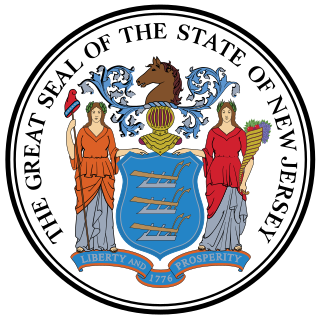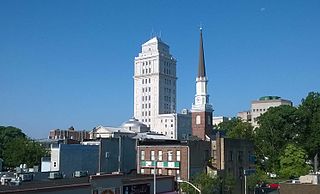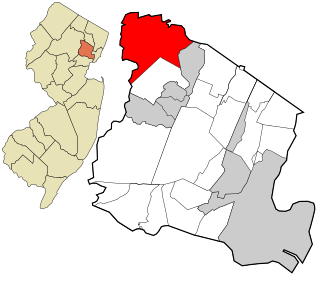Elizabeth Township, also called Elizabethtown, was a township that existed in Essex County, in the U.S. state of New Jersey, from 1664 until 1855.
A township, in the context of New Jersey local government, refers to one of five types and one of eleven forms of municipal government. As a political entity, a township in New Jersey is a full-fledged municipality, on par with any town, city, borough, or village. They collect property taxes and provide services such as maintaining roads, garbage collection, water, sewer, schools, police and fire protection. The Township form of local government is used by 27% of New Jersey municipalities; however, slightly over 50% of the state's population resides within them.

Essex County is a county in the northeastern part of the U.S. state of New Jersey. As of the 2017 Census estimate, the county's population was 808,285, making it the state's third-most populous county, an increase of 3.1% from the 2010 United States Census, when its population was enumerated at 783,969, in turn a decrease of 1.2% from the 793,633 enumerated in the 2000 Census. In 2010, the county dropped down to third-largest, behind Middlesex County, and was one of only two counties in the state to see a decline between 2000 and 2010. Its county seat is Newark, the most populous city in the state. It is part of the New York Metropolitan Area.

In the United States, a state is a constituent political entity, of which there are currently 50. Bound together in a political union, each state holds governmental jurisdiction over a separate and defined geographic territory and shares its sovereignty with the federal government. Due to this shared sovereignty, Americans are citizens both of the federal republic and of the state in which they reside. State citizenship and residency are flexible, and no government approval is required to move between states, except for persons restricted by certain types of court orders. Four states use the term commonwealth rather than state in their full official names.
The area was initially part of the Elizabethtown Tract, purchased from the Lenape on October 28, 1664. [1]
The Elizabethtown Tract was a property that was purchased on October 28, 1664, by John Baily, Daniel Denton and Luke Watson from the Native Americans that is in the area of present-day Elizabeth, New Jersey. The Native American witnesses to the treaty gave their names as Warinanco and Mattano. As specified in the Deed, the purchase included the area "Bounded on the South by a River commonly called the Raritons River, and on the East by the River which Parts Staten-Island and the Main, and to run Northward up after Cull-Bay, till we come at the first River which sets Westwards up after Cull-Bay." The territory encompassed lands from the mouth of the Raritan River and included all of present-day Union County as well as parts of Somerset, Middlesex, Morris and Essex counties.

The Lenape, also called the Leni Lenape, Lenni Lenape and Delaware people, are an indigenous people of the Northeastern Woodlands, who live in Canada and the United States. Their historical territory included present-day New Jersey and eastern Pennsylvania along the Delaware River watershed, New York City, western Long Island, and the Lower Hudson Valley. Today, Lenape people belong to the Delaware Nation and Delaware Tribe of Indians in Oklahoma; the Stockbridge-Munsee Community in Wisconsin; and the Munsee-Delaware Nation, Moravian of the Thames First Nation, and Delaware of Six Nations in Ontario.
Elizabeth-Town Township was formed on October 31, 1693, while the area was still within Essex County. Elizabeth was incorporated as one of New Jersey's initial 104 townships by the Township Act of 1798 Act of the New Jersey Legislature on February 21, 1798. Portions of the township were taken to form Westfield Township (January 27, 1794), Springfield Township (April 14, 1794), Rahway Township (February 27, 1804) and Clinton Township (April 14, 1834). [1]
The Township Act of 1798 is an Act passed by New Jersey Legislature on February 21, 1798 that formally incorporated 104 municipalities in 13 counties in New Jersey. It set standards on format for government of townships. The act was largely replaced by subsequent laws.

The New Jersey Legislature is the legislative branch of the government of the U.S. state of New Jersey. In its current form, as defined by the New Jersey Constitution of 1947, the Legislature consists of two houses: the General Assembly and the Senate. The Legislature meets in the New Jersey State House, in the state capital of Trenton. Democrats currently hold super majorities in both chambers of the legislature.

Westfield is a town in Union County of New Jersey, United States. As of the 2010 United States Census, the town's population was 30,316, reflecting an increase of 672 (+2.3%) from the 29,644 counted in the 2000 Census, which had in turn increased by 774 (+2.7%) from the 28,870 counted in the 1990 Census. In March 2018, Bloomberg ranked Westfield as the 99th wealthiest place in the United States, and the 18th wealthiest in New Jersey. According to a 2014 nationwide survey, Westfield is considered to be the 30th-safest city to live in the United States.
On March 13, 1855, the City of Elizabeth was created, combining and replacing both Elizabeth Township and Elizabeth Borough. With the creation of the City of Elizabeth, Elizabeth Township was dissolved. [1]

Elizabeth is both the largest city and the county seat of Union County, in New Jersey, United States. As of the 2010 United States Census, the city had a total population of 124,969, retaining its ranking as New Jersey's fourth most populous city, behind Paterson. The population increased by 4,401 (3.7%) from the 120,568 counted in the 2000 Census, which had in turn increased by 10,566 (+9.6%) from the 110,002 counted in the 1990 Census. For 2017, the Census Bureau's Population Estimates Program calculated a population of 130,215, an increase of 4.2% from the 2010 enumeration, ranking the city the 212th-most-populous in the nation.
Elizabeth Borough was a borough that existed in Essex County, in the U.S. state of New Jersey, from 1740 until 1855.





